Menu
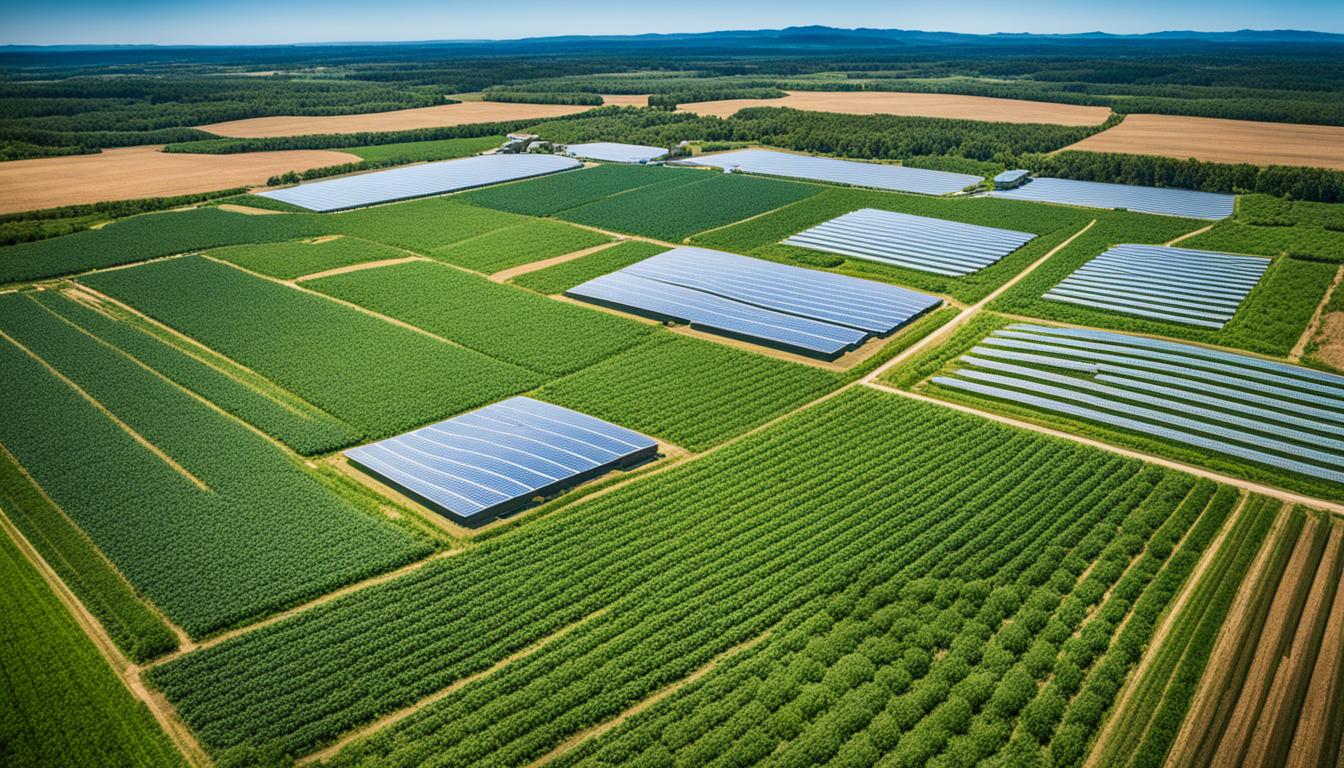
In 2022, around 735 million people worldwide faced chronic hunger. This stark fact shows why the United Nations’ Sustainable Development Goals for farming are crucial. They aim to fight hunger, malnutrition, and poverty.
The United Nations set 17 Sustainable Development Goals (SDGs). These are a plan to change our world for the better. Goals about farming are key to making the planet more sustainable. The aims are to up farming output, cut food losses, and give everyone, especially the most in need, constant access to healthy food.
The SDGs strive for big wins like no undernourished infants and doubling small farmers’ output and earnings. This push for better farming ties together actions on agriculture, water, energy, land, and fighting climate change. They are not just about growing crops. They are about crafting a strong future for everyone, beating severe poverty, and sharing progress broadly.
The United Nations Sustainable Development Goals (SDGs) are a plan to tackle worldwide issues. They were formed in 2015 with 17 goals and 169 targets. These include efforts to end poverty and hunger, address gender inequality, and protect our planet. The SDGs are crucial for creating a better world by 2030.
Before the SDGs, there were important steps like Agenda 21 and the MDGs. A special working group started discussing the SDGs in 2013. Finally, in 2015, they were endorsed at the UN Summit. This process showed how important global teamwork and sharing ideas are.
The main focus of the SDGs is to end poverty across the globe. A key target is to cut poverty to half by 2030. They also aim to make sure everyone has enough to eat by doubling farming productivity. This includes helping small farmers.
Improving health care, education, and fairness between men and women is also crucial. And we must act against climate change and protect our environment. Regular checks and reporting help keep the progress on track. Groups like the DSDG make sure every effort fits with the big picture.
| SDG | Objective | Target Year |
|---|---|---|
| 1 | Eradicate extreme poverty | 2030 |
| 2 | End hunger and double agricultural productivity | 2030 |
| 3 | Reduce global maternal mortality ratio | 2030 |
| 4 | Ensure all girls and boys complete quality education | 2030 |
The SDGs show a clear path to a future where everyone grows together. They focus on helping the planet and making life better for all. By working together, we can face and solve the big problems of today.
Agriculture plays a vital role in tackling hunger and food issues. It aims to end hunger and make sure everyone has enough food to eat. It also focuses on improving nutrition and using farming methods that last. The goal is challenging: we need to see a 100% boost in how well small farms work and earn, and everyone must get enough food every day. Sadly, many around the world face not having enough to eat, with billions more struggling to get by.
Many of the world’s poorest people are small farmers and their families. So, it’s crucial to support them with methods that make their farms more productive and resilient. This might mean smarter ways of using water, growing plants that can survive droughts, and combining old farming wisdom with new scientific discoveries.
The SUN Movement focuses on making sure pregnant women and very young children get the right nutrition. It proves that addressing nutrition early makes a big difference. Also, a goal from the Rio+20 meeting is to not lose more land to farming, which shows how important our land and water are for growing food.
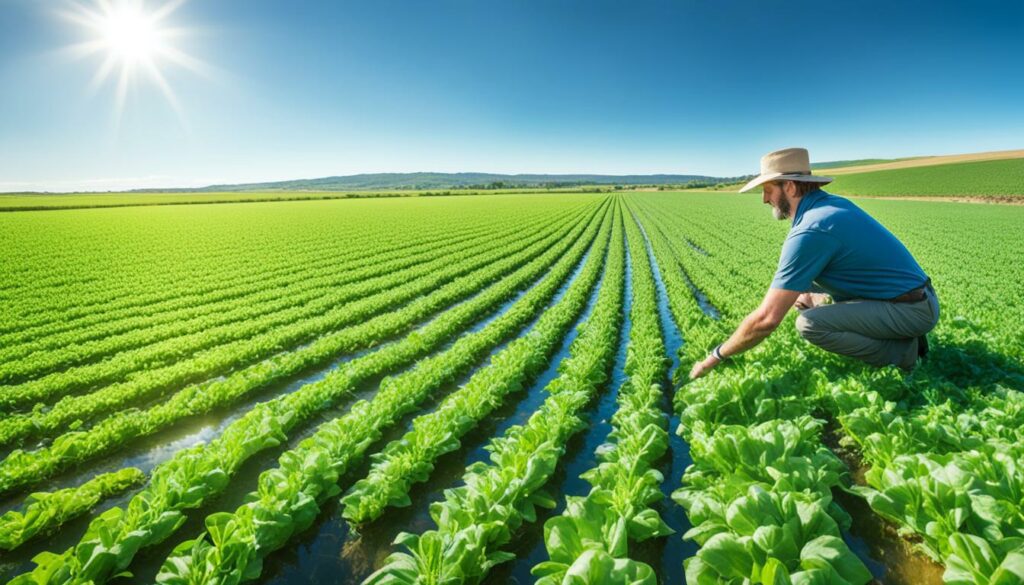
Ending hunger by 2030 is a must, and it will take everyone working together. We need to fix the unfair parts of our food systems and deal with things like wars and diseases, which make it hard for people to eat. We should also put more money into finding new ways to farm sustainably and fight the problems caused by climate change.
It’s key to work together, from local to global levels, on issues like farming, water, energy, and climate change. By using smart and sustainable farming techniques, we can help small farmers and improve our food systems. This way, we can get closer to the big goals of SDG2.
“In 2022, 148 million children suffered from stunted growth, and 45 million children under the age of 5 were affected by wasting. It is projected that more than 600 million people worldwide will be facing hunger in 2030.”
Many United Nations (UN) bodies are working hard on these goals. This includes the International Fund for Agricultural Development, Food and Agriculture Organization, and other key groups. They all aim to make farming better and more sustainable across the globe.
| Key Objectives | Targets |
|---|---|
| End hunger | Ensure access to safe, nutritious food for all |
| Achieve food security | End all forms of malnutrition |
| Sustainable agriculture | Double agricultural productivity and income of small-scale food producers |
The fight against hunger and malnutrition needs sustainable farming. More than 790 million people go hungry worldwide. 2 billion lack regular access to nutritious food. It’s urgent we solve these problems.
The Zero Hunger Challenge works to end hunger. Started at Rio+20, it has bold aims. These include no more stunted children and better food access. Also, it aims to boost small farmers’ productivity and income. In 2022, 2.4 billion people struggle to get enough food. So, we must focus on these targets.
Growing crops with lots of nutrients is key to fighting malnutrition. Southern Asia has 63.9 million stunted children, the most in one area. By introducing biofortified foods and enriched fertilisers, we can help. In sub-Saharan Africa, stunted children have risen from 50.1 to 57.3 million in fourteen years. This underlines the need for better farming for nutrition.
| Region | Stunted Children (Millions) | Food Insecurity (%) |
|---|---|---|
| Southern Asia | 63.9 | 25% |
| Sub-Saharan Africa | 57.3 | 50%+ |
Focusing on nutrient-rich crops and the Zero Hunger Challenge is crucial. It could greatly cut down hunger and malnutrition. This would lead to a healthier world.
Sustainable farming is key to reaching the United Nations Sustainability Goals. Using methods like conservation tillage, rotating crops, and organic fertilisers, we better soil, increase plant and animal variety, and lower harm to the environment.
Conservation tillage means disturbing the soil less. It stops erosion and keeps the soil firm. This way, it keeps water in the ground and helps various organisms live in peace. So, it fits well with sustainable farming practices that aim to keep nature’s balance.
Crop rotation is also crucial for sustainable farming. By changing which plants grow in the same place, farmers fight off pests and weed growth naturally. It helps to make the soil rich in nutrients and not rely too much on chemical fertilisers. This means we can farm for a long time in a way that doesn’t hurt the earth.
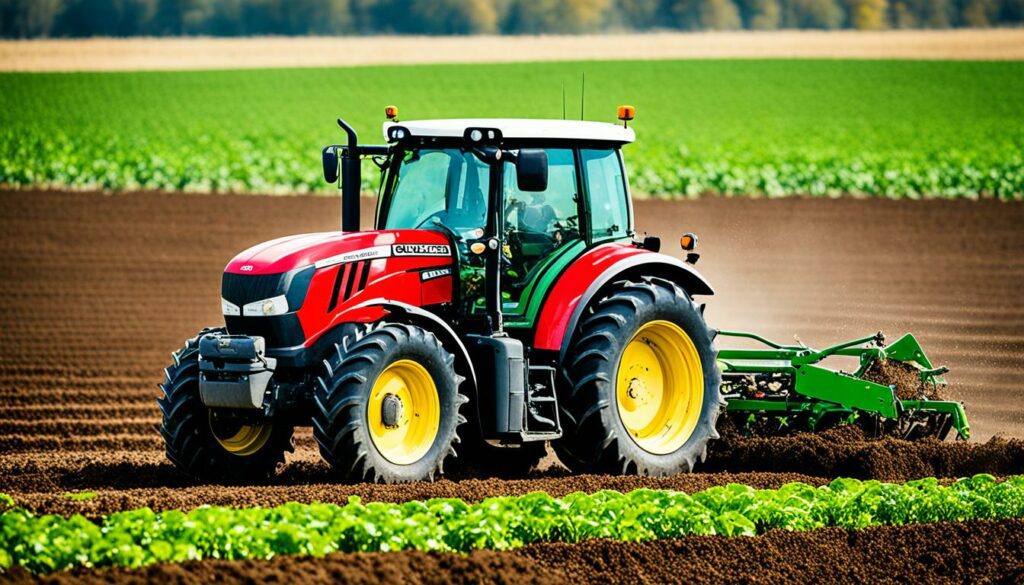
Using organic fertilisers is good for the earth. They make the soil alive and healthy again. These fertilisers give plants what they need without using bad chemicals. This helps in farming for the future and making food better.
| Practice | Benefits |
|---|---|
| Conservation Tillage | Reduces erosion, enhances water conservation, and promotes biodiversity |
| Crop Rotation | Controls pests and diseases, maintains soil nutrient levels |
| Organic Fertilisers | Improves soil fertility, avoids chemical pollutants |
With these sustainable farming practices, we take a big step towards a strong, lasting farm system. Conservation tillage, crop rotation, and organic fertilisers aren’t just ways to farm. They are crucial for keeping nature and farming healthy for those who come after us.
Smallholder farmers play a key role in global agriculture. They are a major part of those living in poverty and going hungry. Boosting smallholder productivity and incomes by 100% is vital for the Zero Hunger Challenge. This shows how important they are for meeting the Sustainable Development Goals (SDGs agriculture).
Helping these farmers means giving them key resources like land, knowledge, and financial help. It also means opening up markets to them. This full support helps grow agriculture and reduce waste, boosting agricultural productivity.
The Scaling-Up Nutrition (SUN) Movement aims to better nutrition by connecting it with other sectors. It highlights the first 1,000 days from pregnancy to a child’s second birthday as vital for health. By improving nutrition in this time, smallholders can play a big role in helping their communities stay healthy.
We must invest in research and development (R&D) for sustainable farming. This is important for adapting to climate change and growing sustainable agriculture by 20% by 2030. Planning for long-term climate change in farming is also crucial.
Additionally, starting a programme to make healthy, nutritious food accessible by 2030 is crucial. This effort directly helps smallholder farmers better prepare for meeting future food needs in a sustainable way.
Gender equality in farming is key for the UN Sustainable Development Goals. It helps close the productivity gap between men and women. Despite improvements, only 26.5% of parliamentary seats worldwide are held by women as of January 2023. We still need focused efforts for equal farming rights.
Empowering women in farming is vital for progress. They need equal resources like land, finance, and market access. In 2021, women held 28.2% of management roles, up just 1% from 2015. Addressing these disparities can also help decrease global hunger.
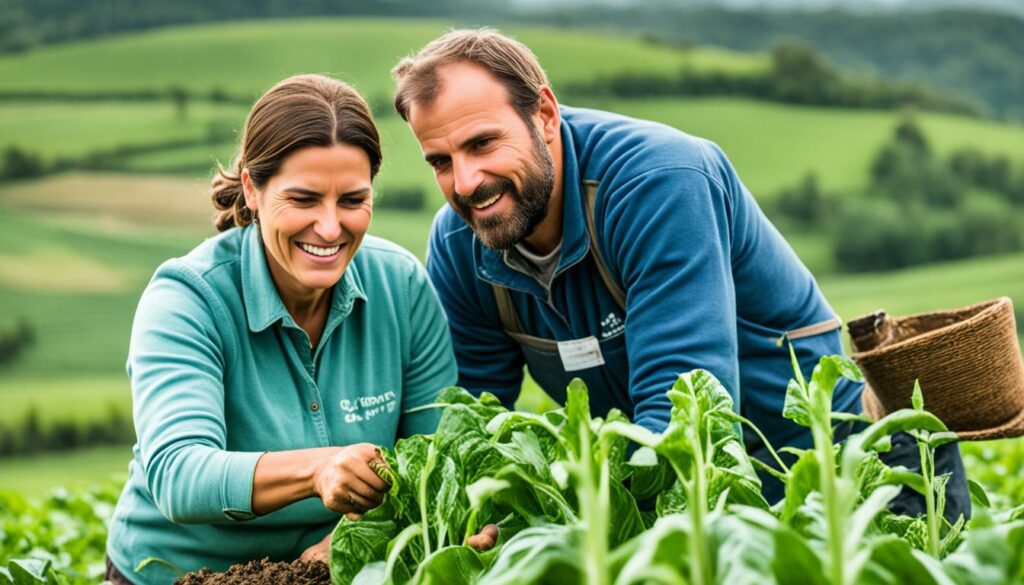
Policies that give women farmers better resource access can have big impacts. For example, giving them fair land rights and educational chances can greatly boost productivity and sustainability in farming. In 2020, 35.4% of local deliberative seats were held by women, showing an increase.
“Empowering women in agriculture not only ensures gender equality in farming but also supports the overarching aim of sustainable development throughout the agricultural sector.”—United Nations Sustainable Development Goals
It’s crucial to focus on gender within the SDGs agriculture strategy. However, many challenges persist. For instance, nearly 45% of global jobs lost in 2020 were from women. Also, only 57% of married women were making decisions about their health rights. This highlights the urgent need for more global efforts to ensure women have equal say in farming.
| Metric | Value |
|---|---|
| Seats in national parliaments (2023) | 26.5% |
| Seats in local deliberative bodies (2020) | 35.4% |
| Management positions held by women (2021) | 28.2% |
| Female lawmakers in national parliaments (2022) | 26.2% |
| Global employment losses (2020) | 45% |
| Autonomous health decisions (2007-2020) | 57% |
| Laws for sexual/reproductive health (2022) | 76% |
Strong efforts in gender equality will make a big difference in farming. It will push forward women’s rights and achieve SDGs in agriculture. By focusing on equality, we enhance farming’s growth and meet SDGs better. This also builds a stronger and more sustainable global agriculture.
Sustainable agriculture is key in fighting climate change. It uses methods such as storing carbon in soil. It also uses crops that can handle the changing climate. These actions show how farming can adjust and help the planet.
Storing carbon in the soil is a big part of a good farming strategy. It helps a lot by cutting down the amount of greenhouse gases in the air. Farming this way is not only good for the planet but also increases how much food we can grow on the land.
It’s important to keep investing in how we can store more carbon. Billions of dollars are being put into this each year. This shows there’s a strong push to make our food production more friendly to the earth. This effort is key in the fight against climate change.
Creating crops that can survive harsh weather is crucial. These special crops can handle things like dry spells and heavy rains. They make sure we can still grow food even when the climate goes crazy.
Many important projects are working to make more of these strong crops. They want to help farmers who don’t have a lot and help them grow more food. Doing this will help ensure there’s enough to eat for everyone.
Small-scale farmers need essential resources to grow and last. They’re key to solving food problems globally. These resources include money services, better connections to markets, and farming things that won’t harm the earth.

Access to financial services is vital for small farmers. It boosts what they can do and how well they can deal with problems. Financial inclusion lets them invest in better farming and new tech.
It helps them buy seeds, fertilisers, and tools. Also, insurance can protect them from bad weather that ruins crops. This keeps their lives safe when things outside of their control go wrong.
Getting to sell goods easily is key for small farmers. Better access to markets makes this happen. It links country and city areas. This way, they can sell their harvests smoothly.
Strong markets for small farmers also cut down on lost goods after harvest. It makes their earnings better. Plus, having the right places to store goods and ways to get them to people means the food is good when it reaches the consumers. This all helps secure food and keeps the economy steady.
Combining good ways to farm with money services is key for small farmers moving forward. These steps build a strong base for farming that helps feed the world and lessens hunger. By making resources more available, we make farming better. This shows how crucial small farmers are for feeding everyone around the world.
| Region | Food Insecurity Level | Stunted Children (2000-2014) | Overweight Children (2000-2014) |
|---|---|---|---|
| Sub-Saharan Africa | High | 50.1M to 57.3M | 5% to 6% |
| Southern Asia | Moderate to Severe | Most Progress in Reducing | N/A |
| Worldwide | N/A | 158.6M affected in 2014 | 5% to 6% |
| Northern Africa | N/A | N/A | Highest Prevalence (16%) |
Sustainable farming brings giant benefits to rural areas. It tackles economic problems and makes sure people have enough food. This way of farming helps farms produce more and reach more markets. This is key for farmers who are poor and live far from cities.
Using sustainable ways to farm has brought more money to farmers. Better water use and storage mean farmers can grow more food. So, they make more money. In fact, goals like the Zero Hunger Challenge want to double what farmers produce. This shows we’re making a big change in helping farmers leave poverty.
Getting enough food is a big challenge for many. Over 828 million people in the world go hungry every day. Using sustainable farming helps deal with this problem. The SUN Movement makes sure farming helps people get the food they need. They aim for everyone to have enough good food all the time.
Now, let’s look at some clear wins from sustainable farming:
| Key Outcome | Target | Progress |
|---|---|---|
| Zero Stunted Children | No child under two years old is stunted | On track |
| Food Access | 100% access to adequate food all year round | Significant progress |
| Small Holder Productivity | 100% increase in productivity and income | Progressing |
Using this whole approach doesn’t just help farming grow. It also makes rural communities stronger. Together, sustainable farming really cuts down on poverty. It makes sure these areas have a future where they can thrive and be secure.
Using innovative technologies in agriculture is very important. It’s changing normal farming into more sustainable systems. Things like precision tools, biotech, and digital tech are making a big difference. They help us work towards the United Nations’ goals for a better world.
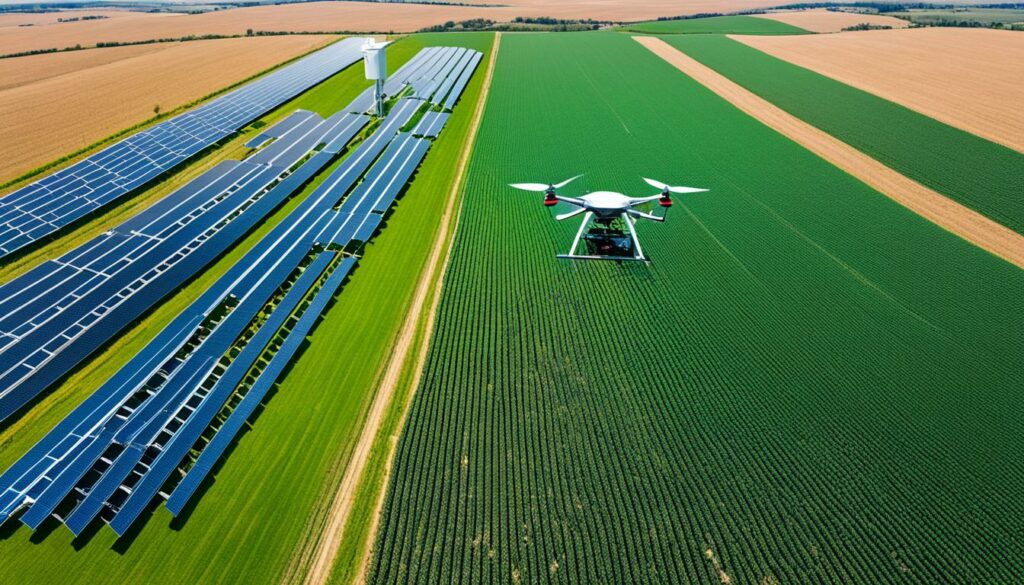
In 2021, the number of hungry people worldwide hit 828 million. This highlights the huge need for new farming solutions. Here’s a look at the situation by region:
| Region | Number of People Affected by Hunger (in millions) | Percentage of Total |
|---|---|---|
| Asia and the Pacific | 526 | 9% |
| Africa | 267 | 20% |
| Latin America / Caribbean | 48 | 8.6% |
| Developed Countries | 16 | 2% |
Precision agriculture technologies are a big help. They let farmers use resources better and do less harm to the environment. Making farming more efficient is crucial. We need productivity to go up by 2030 to meet food needs.
Technology has also cut down on greenhouse gases a lot. For every dollar put into making crops better, 68kg of emissions are saved. This has stopped 161 gigatonnes of carbon going into the air.
But saving emissions is not the only benefit. Putting $239 billion into farming will bring back $3.1 trillion. Improvements like helping women farmers could make a huge difference. They might produce 20-30% more food.
Digital tech is a game changer for farmers too. It helps them reach more markets and learn new things, like with the Cultiv@te programme. This is all a part of the world’s big plan for farming, making sure it helps the planet.
Across the globe, about a third of all food made doesn’t get eaten. This leads to big economic and environmental harm. Roughly, 14% of food worth around USD400 billion is lost before reaching shops. Another 17% is wasted at the shop and by people. To make farming more sustainable, cutting food loss and waste is key.
To cut food loss, how we handle food after it’s picked is vital. Using the right storage, like cold rooms, makes food last longer. In places like sub-Saharan Africa, where losses hit $4 billion yearly, better methods are needed. Building updated facilities and teaching farmers new skills can save a lot of food.
Creating efficient supply chains is crucial too. Good transport means food reaches us faster, reducing spoilage. It takes producers, suppliers, and shops working together smoothly. Also, giving away extra food can help those in need and the planet. Making the public aware and setting rules to cut food loss and waste are very important.
“SDG target 12.3 focuses on reducing food loss and waste, highlighting the necessity of global collaborative efforts to achieve these objectives as part of the Sustainable Development Goals (SDGs).”
When we waste food, we waste other resources like water and energy too. It’s vital we know where food is lost and why. This way, we can really make a change and benefit from wasted food reduction. Effective leadership, skills building, and investing in new tech are needed.
Keeping soil healthy and fertile is crucial for farming sustainably. It also helps meet the United Nations’ Sustainable Development Goals (SDGs). A key aim is to have 75% healthy soil by 2030. This target is important because soil health is linked to food safety, strong ecosystems, and fighting climate change.
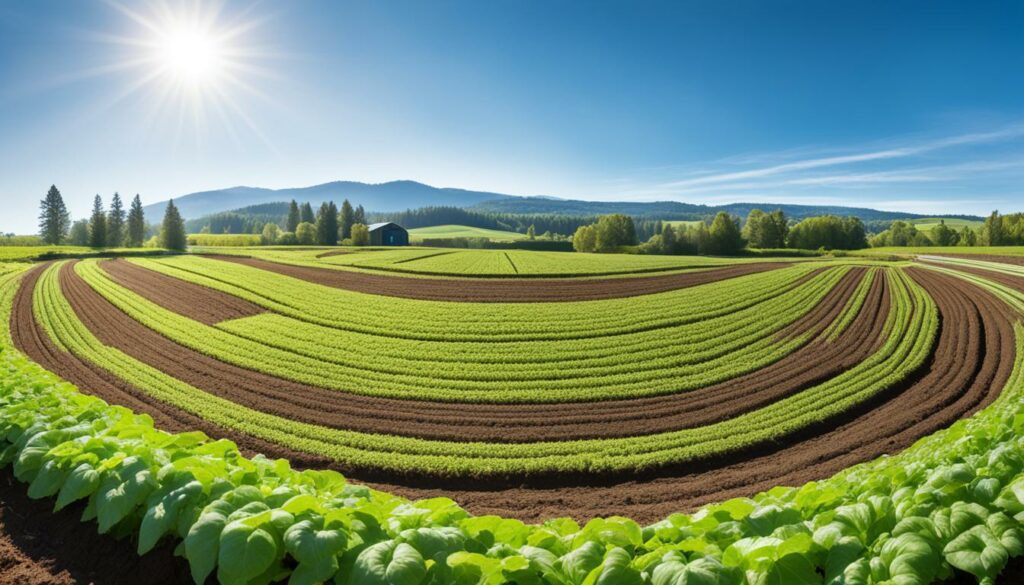
Growing different crops in a planned way, using less invasive methods to till the land, and farming without chemicals help the soil. These methods add variety and rich carbon levels to the soil. They also cut down on losing nutrients and soil when it rains. Doing this less harms the environment and helps keep carbon locked in the soil to fight climate change.
When we take good care of the soil, tiny living things in it grow. This makes the soil better at holding water and staying together, stopping it from turning into desert and wasteland. Helping soil this way matches goals aiming to protect life on land.
Fertilisers with extra needed nutrients are vital for better soil and farm growth. They help meet the SDG 2 goal of No Hunger by making harvests bigger. Still, it’s important not to use too much to avoid harming the soil and water. Smart use of these fertilisers with good soil practices means farms can keep working well for a long time without hurting the environment.
| SDG Goals | Impact of Soil Health | Relevant Practices |
|---|---|---|
| Goal 2: Zero Hunger | 95% food production linked to soil health | Micronutrient-enriched fertilisers, crop rotation |
| Goal 13: Climate Action | Reduces inputs and carbon footprint | Carbon sequestration, minimising nutrient leaching |
| Goal 15: Life on Land | Prevents soil desertification and degradation | Soil management, organic farming |
| Goal 6: Clean Water and Sanitation | Prevention of eutrophication | Balanced fertilizer use |
Getting sustainable agriculture right needs a huge worldwide push. Everyone has to join forces to deal with many problems. In 2012, at the Rio+20 Conference, all leaders agreed that everyone should have enough safe and healthy food. This important agreement shows why the whole world must work together. It’s to beat problems like not having enough food or going hungry.
The SUN Movement has been shaking things up for 13 years. It’s making a big difference, especially in places where farmers don’t have much. They’re focusing on nutrition everywhere to help these communities fully.
But, there’s still a big challenge with land getting worse. This threat is everywhere and needs countries to make smart choices together. They should work closely on farming, water, energy, land, and dealing with the changing climate. This way, things can get better and stronger.
Worldwide, about 828 million people don’t have enough food, and most are in the countryside. The crisis hits places differently: 418 million struggling in Asia and the Pacific, 157 million in Africa, 96 million in Latin America plus the Caribbean, and 16 million in richer countries. Investing in new research, technology, and how we do things is key. It makes our food systems more stable, even when the climate gets tough.
Putting a lot of money – about $239 billion for 15 years – into farming better will be a great move. It’s expected to create a benefit of $3.1 trillion. This big cash push isn’t just about making more food. It’s also about easing off something bad for the planet – cutting down how much we pollute. For every dollar we invest, this could save 68kg of carbon. Altogether, that might stop about 161 gigatonnes of harmful gas going into the air.
| Region | Population Affected by Hunger (in millions) |
|---|---|
| Asia and the Pacific | 418 |
| Africa | 157 |
| Latin America/Caribbean | 96 |
| Developed Countries | 16 |
It’s essential to put more money into farming, especially in poor countries. We need to learn together and work across borders. This is how we will reach the farming goals of the United Nations. It will help us all have a reliable food source in the future.
Putting money into sustainable farming can help us fight problems like not having enough food and climate issues. These chances for growth cover many fields, from public and private investments to working with other countries in farming. They help us deal with hunger, cut down on waste, and grow economies. This is important for reaching the United Nation’s goals for the future.
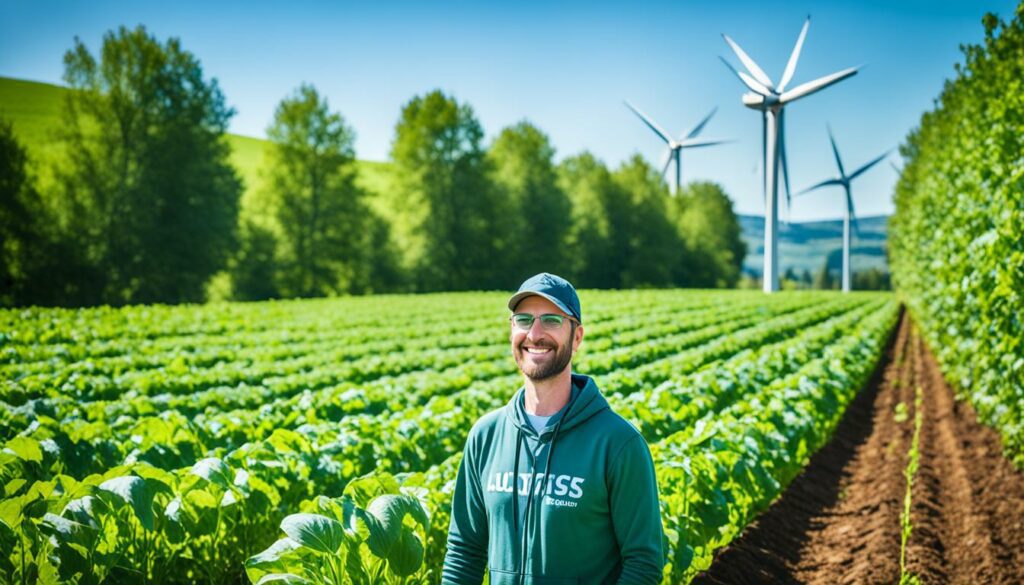
Both public and private groups working together is key for more investment in sustainable farming. Investing in good plans and keeping funds steady helps. With such efforts, we can improve our basic setups and try out new tools. A big investment in rural areas, like $239 billion over 15 years, could give back a lot, up to $3.1 trillion. This money would help with vital things like fixing roads and making sure power and communication are easily available. All of this helps farming be more productive and eco-friendly.
To have farming that lasts worldwide, everyone has to work together. This means people from different countries sharing what they know and helping each other. The United Nations and groups like the Global Reporting Initiative work to make sure these partnerships happen. They try to fix unfair trading to stop the prices of food from changing too much, which helps all nations, rich and poor.
When we link what the public and private sectors do and work with others globally, we make a big difference. This helps the farming industry aim towards meeting the goals for a better future. Supporting sustainable farming leads to healthier people, more food grown, and economies that can withstand tough times. It’s a win for everyone.
Farming under the SDGs means using a plan that mixes farming with bigger goals for the planet. This approach shows how farming can help the world as a whole. It’s key to our sustainable future.
To meet the SDGs for farming, we need a full-packed approach. Farms should grow in a way that everyone gets enough food, and no child is undernourished. All farm systems should be sustainable and help small farmers grow more food.
Stopping food from being lost or wasted is critical. So is looking after nutrition, especially in the 1,000 days from when a mother is pregnant until her child turns two.
The future of farming has its challenges. One big issue is making sure the land stays healthy for growing food. This is extra important in places where poverty and hunger are tough.
It’s key to make smart choices about farming. And we need to invest in new farming tech. These steps are essential for a farming future that’s good for farmers and the planet.
The UN’s High-level Forum on Sustainable Development is vital for checking and improving on these goals. With hard work and clever ideas, we can solve farming’s complex issues. This sets the path for a future where everyone has enough good food.
Sustainable farming is key in meeting the United Nations’ Sustainable Development Goals (SDGs). As of 2022, over 700 million people dealt with chronic hunger. This highlights why we must focus on sustainable farming to achieve these goals.
With around 2.4 billion facing food security issues, deep change is needed. We have to act in a coordinated way and find new solutions in farming. This way, we can help more effectively.
Getting to these big goals will need us to see farming in a new light. It’s not just about more food. It’s about less waste. It’s about making sure everyone can get healthy food, especially those who need it most.
Although there was progress in fighting hunger till 2016, signs now point to food problems increasing. This shows us we need to act quickly.
Today, over 790 million people are still hungry. This includes 148 million children not growing well and 45 million very young children being too thin. Now more than ever, we need to change how we grow our food. Investing in sustainable farming is a must. This will help us reach a world where everyone has enough to eat.
Pushing forward to 2030 and further, our fight for the SDGs in farming is crucial. Working together, we can make sure everyone benefits from a healthier, more food-secure world. Change is possible through our shared commitment to making farming sustainable.
The United Nations Sustainable Development Goals are 17 worldwide aims. They deal with issues like poor hunger and ensuring sustainable farming. These goals stress the vital part farming plays. They push for new ideas and teaming up to make farms more productive but also safe for the environment.
The SDGs came from previous efforts such as Agenda 21 and the Millennium Development Goals. They were started at the Rio+20 Conference in 2015 by the UN Member States. These goals aim to join the world in working together. They aim for a sustainable future in many areas.
Farming is key in reaching SDG2. This goal is about stopping hunger, making sure there’s enough food, and improving diet. It aims to increase how much food we can grow. It also focuses on making sure everyone, including small farmers, and women, has enough to eat.
The Zero Hunger Challenge started at the Rio+20 Conference. It calls for a global push to end hunger and severe lack of food. Its goals include no stunted children and everyone having enough to eat. It also wants to help small farmers make more money. This approach also helps fight diseases caused by bad diets.
Nutrient-rich crops are vital for healthy and lasting farming. They fight against not getting enough nutrients. Using special foods and fertilisers makes crops better for us. This helps tackle not having enough good food to eat.
Practices like conservation tillage and crop rotation are promoted. So is using natural fertilisers. These help keep the soil well and support more plants and animals. They also help fight against bad effects on the environment. This all leads to more food and farms that can last a long time.
Empowering small farmers is about giving them land and the right knowledge. It also means making sure they can get loans and sell what they grow. Helping them to make more and be part of new, good ways, is key to meeting the SDGs. This way, farming and life can get better at the same time.
Gender equality is very important for the SDGs, especially in farming. Giving women farmers the same chances makes a big difference in fighting hunger. It’s about making sure men and women can do farming equally well. This brings long-term benefits to everyone through fair and sustainable growth.
Sustainable farming fights climate change by storing carbon in the ground and growing tough plants. These methods help deal with and lessen the bad effects of our changing climate. They also help keep nature diverse, save water, and use the soil in ways that keep it good for the future.
For small farmers to do well, they need good ways to get and sell things and to build. These include better markets and ways to move what they grow. It also means having money and things to keep them safe, so they can grow and be part of a bigger, better farming world.
Sustainable farming helps countryside people be less poor by letting them make more and sell better. This not only brings more food but also a way for farmers to move up in life. These steps connect growing things with making life better, touching both food and the welfare of people.
New technologies change farming for the better by solving old problems in smart ways. Things like precise tools, science in farms, and online links for selling and learning, make more from less. They lower waste and help farmers be part of a more lasting, productive future.
Less lost food means more and better food for everyone and less harm to the earth. Smart ways to handle food after it’s picked, keep it cool, and move it, cut waste. This does a lot for letting food get to people in need and keeps our planet healthier.
Keeping soil in good shape relies on good care and the right foods for plants. This makes soil grow more food that’s good for us. It also keeps farms strong for the years to come, looking after nature and our ability to grow things.
Worldwide farming that lasts needs nations to work together, help with money, and have good rules. It needs everyone’s know-how, working together over borders, to secure a future where we all have enough good food.
Investing in lasting farms covers private, public, and global efforts. Money goes to making things better, like tech, farms, and helping farmers do more. These moves are crucial for achieving the SDGs by making farming and life better all around.
The future farming face is about dealing with tough new needs, like less resources and feeding more. But it’s also a chance to do things in new and better ways that last. Here, finding new ideas and bringing everyone in to do farming well and fairly is the way ahead.